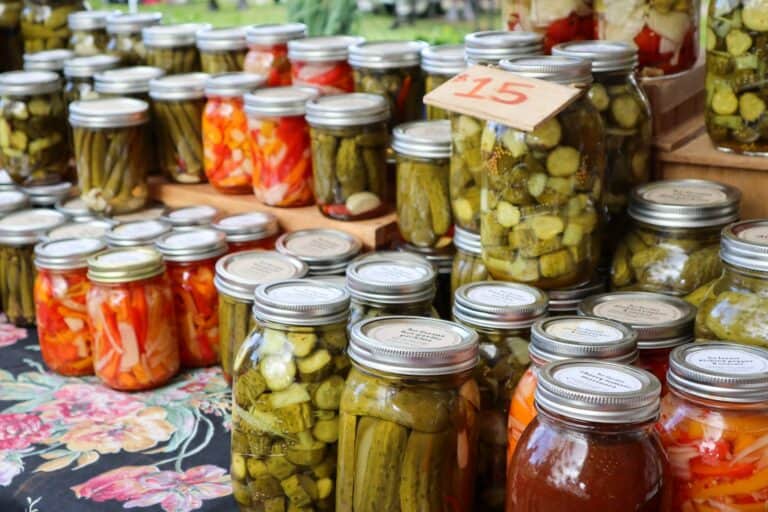Fermenting vegetables at home is a wonderful way to create flavorful and nutritious foods. This ancient technique of preserving food not only enhances the taste but also promotes gut health by supporting the growth of beneficial bacteria. In this step-by-step guide, we will explore the fascinating process of fermenting vegetables at home, including the benefits of lacto fermented vegetables, the fermentation process itself, and some delicious fermented vegetable recipes.
What is Fermentation?

Fermentation or lactic acid fermentation is a natural process that occurs when lactic acid bacteria convert sugar into lactic acid, creating an anaerobic environment. This process not only preserves the vegetables but also produces tangy flavors and textures that we associate with fermented foods. Lactic acid bacteria are beneficial microorganisms that support gut health and contribute to the diverse ecosystem of the gut microbiome.
Fermenting Vegetables at Home
Step 1: Prepare the Vegetables
To begin fermenting vegetables at home, start by choosing your vegetables. You can use any type of vegetable, such as carrots, cabbage, green beans, or a mix of your favorites. Wash the vegetables thoroughly and chop them into desired sizes. It is crucial to ensure that the ferment vegetables are clean to avoid any harmful bacteria contaminating the fermentation process.
Step 2: Create a Brine

In a separate container, prepare a brine by dissolving non-iodized salt in cold water. The ratio of salt to water is usually around 2 tablespoons of salt per quart of water, but this can vary depending on personal preference. Just make sure vegetables submerged in the salt water properly. It’s essential to use non-iodized salt while fermenting veggies, as iodized salt may contain anti-caking agents that can hinder the fermentation process.
Step 3: Submerge the Vegetables
Take a fermentation crock or a clean mason jar and place the chopped vegetables inside. Pour the brine over the vegetables, making sure they are completely submerged. This step is crucial to create an oxygen-free environment that allows the fermentation process to occur.
Step 4: Add a Starter Culture (Optional)
Adding a starter culture can accelerate the fermentation process and introduce specific strains of lactic acid bacteria. If you choose to use a starter culture, follow the instructions provided. However, it is important to note that fermentation can occur naturally without the addition of a starter culture.
Step 5: Seal the Jar Tightly

Cover the fermentation crock or mason jar with a lid, ensuring it is tightly sealed. This prevents oxygen from entering and allows the fermentation to take place in an anaerobic environment.
Step 6: Find the Perfect Spot
Place the sealed jar in a dark, cool place away from direct sunlight. The fermentation process thrives in a stable environment, and exposure to sunlight can lead to undesirable changes in taste and texture.
Step 7: Patience is a Virtue
The fermentation process takes time, usually ranging from a few days to several weeks, depending on personal preference and the type of vegetables used. It is essential to taste the vegetables periodically to determine the desired level of fermentation. Once you achieve the desired taste, move the jar to the refrigerator to slow down the fermentation process and extend the shelf life.
Step 8: Enjoy your Fermented Vegetables!
Once the fermentation process is complete, your vegetables are ready to be enjoyed. They can be served as a side dish, added to salads, or used as a flavor-enhancing ingredient in various recipes. The tangy taste and unique texture of fermented vegetables can elevate any meal and provide a multitude of health benefits.
Fermenting Vegetables at Home – Final Thoughts
Fermenting vegetables at home is a simple and rewarding process that allows you to experiment with flavors and create delicious fermented veggies. By harnessing the power of lactic acid bacteria, you can support gut health and preserve the nutritional value of the fermented food. So, why not try your hand at fermenting vegetables today and embark on a journey of taste, health, and food preservation? Let your creativity flourish by exploring various vegetable combinations and recipes inspired by the wonderful world of fermentation.
- Vegetables Good For The Skin
- Vegetables With Indian Food
- Vegetarian And Meat Eater Couple Recipes
- Vegetarian Foods
- Vegetarian Road Trip Food
- 10 Mouthwatering Vegetarian Keto Recipes
- 10 Surprising Vegetarian Food For Weight Gain
- Summer Recipes For Vegetarians
- The Benefits Of A Lacto Vegetarian Diet
- The Great Twix Debate Are Twix Vegan
- The Health Benefits Of Vegan Eating
- Top 10 Vegetables That Give You Energy
- Tips To Get Children To Love Veggies
- Amazing Vegan Onion Bhaji Sandwich
- Anti Inflammatory Vegetables
- Sensational Meals With Vegetables
- Healthy Vegetable Recipes For Weight Loss
- Healthy Vegetarian Stew
- 8 Satisfying Vegetarian Salad Ideas
- Eating More Cruciferous Vegetables
- Fermenting Vegetables At Home
- Healthy And Creative Vegetable Pasta Dishes
- Leftover Vegetable Scraps
- No Cooking Vegetarian Meals

